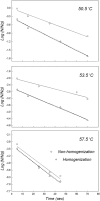Effective inactivation of Saccharomyces cerevisiae in minimally processed Makgeolli using low-pressure homogenization-based pasteurization
- PMID: 25897411
- PMCID: PMC4398680
- DOI: 10.1186/s40064-015-0936-4
Effective inactivation of Saccharomyces cerevisiae in minimally processed Makgeolli using low-pressure homogenization-based pasteurization
Abstract
In order to address the limitations associated with the inefficient pasteurization platform used to make Makgeolli, such as the presence of turbid colloidal dispersions in suspension, commercially available Makgeolli was minimally processed using a low-pressure homogenization-based pasteurization (LHBP) process. This continuous process demonstrates that promptly reducing the exposure time to excessive heat using either large molecules or insoluble particles can dramatically improve internal quality and decrease irreversible damage. Specifically, optimal homogenization increased concomitantly with physical parameters such as colloidal stability (65.0% of maximum and below 25-μm particles) following two repetitions at 25.0 MPa. However, biochemical parameters such as microbial population, acidity, and the presence of fermentable sugars rarely affected Makgeolli quality. Remarkably, there was a 4.5-log reduction in the number of Saccharomyces cerevisiae target cells at 53.5°C for 70 sec in optimally homogenized Makgeolli. This value was higher than the 37.7% measured from traditionally pasteurized Makgeolli. In contrast to the analytical similarity among homogenized Makgeollis, our objective quality evaluation demonstrated significant differences between pasteurized (or unpasteurized) Makgeolli and LHBP-treated Makgeolli. Low-pressure homogenization-based pasteurization, Makgeolli, minimal processing-preservation, Saccharomyces cerevisiae, suspension stability.
Keywords: Low-pressure homogenization-based pasteurization; Makgeolli; Minimal processing-preservation; Saccharomyces cerevisiae; Suspension stability.
Figures






Similar articles
-
Effect of homogenization and pasteurization on the structure and stability of whey protein in milk.J Dairy Sci. 2015 May;98(5):2884-97. doi: 10.3168/jds.2014-8920. Epub 2015 Feb 20. J Dairy Sci. 2015. PMID: 25704975
-
Effects of fat content, pasteurization method, homogenization pressure, and storage time on the mechanical and sensory properties of bovine milk.J Dairy Sci. 2018 Apr;101(4):2941-2955. doi: 10.3168/jds.2017-13568. Epub 2018 Feb 2. J Dairy Sci. 2018. PMID: 29398020
-
Feasibility of brewing makgeolli using Pichia anomala Y197-13, a non-Saccharomyces cerevisiae.J Microbiol Biotechnol. 2012 Dec;22(12):1749-57. doi: 10.4014/jmb.1210.10038. J Microbiol Biotechnol. 2012. PMID: 23221539
-
Applications of High and Ultra High Pressure Homogenization for Food Safety.Front Microbiol. 2016 Aug 3;7:1132. doi: 10.3389/fmicb.2016.01132. eCollection 2016. Front Microbiol. 2016. PMID: 27536270 Free PMC article. Review.
-
Principles and application of high pressure-based technologies in the food industry.Annu Rev Food Sci Technol. 2015;6:435-62. doi: 10.1146/annurev-food-022814-015539. Epub 2015 Feb 26. Annu Rev Food Sci Technol. 2015. PMID: 25747234 Review.
Cited by
-
Potential Use of Emerging Technologies for Preservation of Rice Wine and Their Effects on Quality: Updated Review.Front Nutr. 2022 Jun 23;9:912504. doi: 10.3389/fnut.2022.912504. eCollection 2022. Front Nutr. 2022. PMID: 35811939 Free PMC article. Review.
References
-
- Andrews AT, Brooker BE, Hobbs DG. Properties of aseptically packed ultra-heat-treated milk: electron microscopic examination of changes occurring during storage. J Dairy Res. 1977;44:283–292. doi: 10.1017/S0022029900020215. - DOI
-
- Bae SM, Kim HJ, Oh TK, Kho YH. Preservation of Takju by pasteurization. Kor J Appl Microbiol Biotechnol. 1990;18:322–355.
-
- Bautista-Muñoz C, Boldo XM, Villa-Tanaca L, Hernández-Rodríguez C. Identification of Candida spp. by randomly amplified polymorphic DNA analysis and differentiation between Candida albicans and Candida dubliniensis by direct PCR methods. J Clin Microbiol. 2003;41:414–420. doi: 10.1128/JCM.41.1.414-420.2003. - DOI - PMC - PubMed
LinkOut - more resources
Full Text Sources
Other Literature Sources

